Back to search results
BAIRNSDALE COURT HOUSE
14 NICHOLSON STREET BAIRNSDALE, EAST GIPPSLAND SHIRE
BAIRNSDALE COURT HOUSE
14 NICHOLSON STREET BAIRNSDALE, EAST GIPPSLAND SHIRE
All information on this page is maintained by Heritage Victoria.
Click below for their website and contact details.
Victorian Heritage Register
-
Add to tour
You must log in to do that.
-
Share
-
Shortlist place
You must log in to do that.
- Download report

BAIRNSDALE COURT HOUSE SOHE 2008


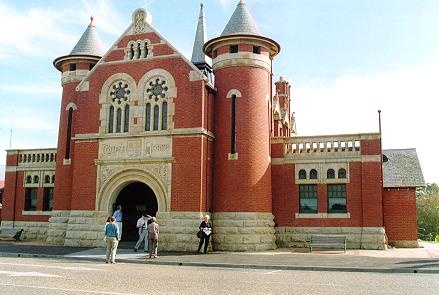





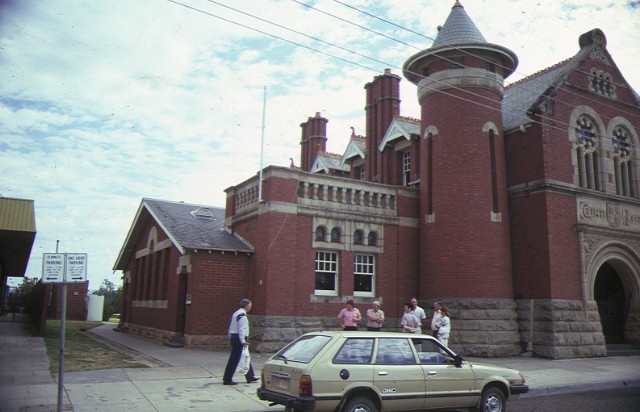














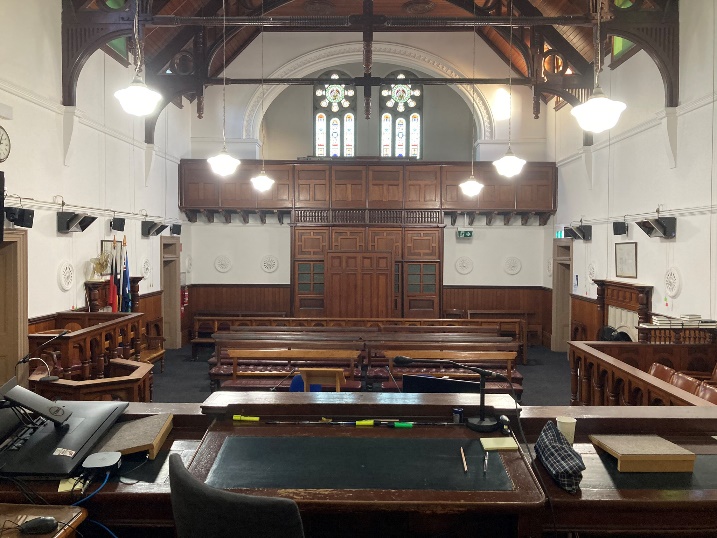


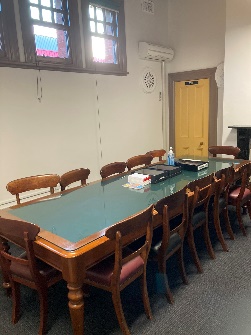
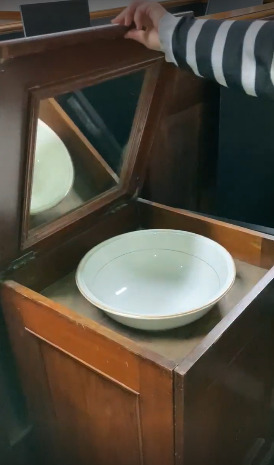
On this page:
Statement of Significance
What is significant?
The Bairnsdale Court House is double-storey and of red brick construction (1893) designed by architect AJ Macdonald of the Victorian Public Works Department (PWD) in an eclectic blend of Art Nouveau, Romanesque, Queen Anne, and Scottish Baronial styles with Australian decorative elements, and objects integral being court room furniture.
How is it significant?
The Bairnsdale Court House is of historical, architectural, and technical significance to the State of Victoria. It satisfies the following criterion for inclusion in the VHR:
Criterion A
Importance to the course, or pattern, of Victoria’s cultural history.
Criterion D
Importance in demonstrating the principal characteristics of a class of cultural places and objects
Criterion F
Importance in demonstrating a high degree of creative or technical achievement at a particular period.
Criterion A
Importance to the course, or pattern, of Victoria’s cultural history.
Criterion D
Importance in demonstrating the principal characteristics of a class of cultural places and objects
Criterion F
Importance in demonstrating a high degree of creative or technical achievement at a particular period.
Why is it significant?
The Bairnsdale Court House is technically significant for the Tobin Tube ventilation system in the building which has survived with a high degree of integrity. It demonstrates an important technical innovation, adopted in many Victorian public buildings in the late nineteenth century. It was an important innovation for introducing fresh air into public buildings without creating draughts.
(Criterion F)
Show more
Show less
-
-
BAIRNSDALE COURT HOUSE - History
The Bairnsdale Court House was built in 1893 during the severe economic depression of the 1890s during which few public court houses were built. The Bairnsdale Court House had been planned in more prosperous times, and once construction commenced it provided employment opportunities for builders and tradesmen. Designed by the Melbourne born, Edinburgh trained architect AJ Macdonald of the Victorian Public Works Department (PWD), the court house is extravagant in design and one of only sixteen works attributable to Macdonald. Macdonald’s time with the PWD was brief, but his output notable, including the Omeo Court House (VHR H1536), Omeo Post Office (VHR H0650), and Flemington Court House and Police Station (VHR H1470). After retiring from architecture at thirty-two, Macdonald worked in several other State and Commonwealth departments, with a brief intermission during which he assisted Walter Burley Griffin and Marion Mahony Griffin in the planning of Canberra.
The supervising architect for the Bairnsdale Court House was local resident, Harry French, and the builder for the project was Peter Rodger of Williamstown. Other tradesmen included local craftsmen and bricklayers. At the time priority was given to the sourcing of local materials for construction. An article in the Bairnsdale Advertiser after construction was completed refers to the use of ‘the finest local red bricks, with stone dressings of Mount Taylor and Mount Lookout freestone, and mountain ash timber for the interiors’. Internally, a Tobin Tube system was installed for ventilation purposes. The Tobin Tube consisted of a horizontal opening in the exterior wall that connected to an opening on the inside of the wall with a vertical tube. At Bairnsdale, the Tobin tubes can still be opened and closed by hand with the ornamental vents in the rooms.
The building continues to be used as a court house and provides important court services to the East Gippsland region. While there have been minor updates over time, the court house remains intact to the era of its construction. The Bairnsdale Koori Court convenes in Court room 2 (the Magistrate’s Court) around a large modern table. Mention that the local Koori Court convenes in Court Room 2, around a large modern table. The Koori Court at Bairnsdale marks an important development in Victoria’s justice systemBAIRNSDALE COURT HOUSE - Assessment Against Criteria
Criterion
The Bairnsdale Court House is of historical, architectural, and technical significance to the State of Victoria. It satisfies the following criterion for inclusion in the VHR:
Criterion A
Importance to the course, or pattern, of Victoria’s cultural history.
Criterion D
Importance in demonstrating the principal characteristics of a class of cultural places and objects
Criterion F
Importance in demonstrating a high degree of creative or technical achievement at a particular period.
BAIRNSDALE COURT HOUSE - Permit Exemptions
General Exemptions:General exemptions apply to all places and objects included in the Victorian Heritage Register (VHR). General exemptions have been designed to allow everyday activities, maintenance and changes to your property, which don’t harm its cultural heritage significance, to proceed without the need to obtain approvals under the Heritage Act 2017.Places of worship: In some circumstances, you can alter a place of worship to accommodate religious practices without a permit, but you must notify the Executive Director of Heritage Victoria before you start the works or activities at least 20 business days before the works or activities are to commence.Subdivision/consolidation: Permit exemptions exist for some subdivisions and consolidations. If the subdivision or consolidation is in accordance with a planning permit granted under Part 4 of the Planning and Environment Act 1987 and the application for the planning permit was referred to the Executive Director of Heritage Victoria as a determining referral authority, a permit is not required.Specific exemptions may also apply to your registered place or object. If applicable, these are listed below. Specific exemptions are tailored to the conservation and management needs of an individual registered place or object and set out works and activities that are exempt from the requirements of a permit. Specific exemptions prevail if they conflict with general exemptions. Find out more about heritage permit exemptions here.BAIRNSDALE COURT HOUSE - Permit Exemption Policy
Specific Exemptions
The works and activities below are not considered to cause harm to the cultural heritage significance of the Bairnsdale Court House subject to the following guidelines and conditions:
Guidelines
1. Where there is an inconsistency between permit exemptions specific to the registered place or object (‘specific exemptions’) established in accordance with either section 49(3) or section 92(3) of the Act and general exemptions established in accordance with section 92(1) of the Act specific exemptions will prevail to the extent of any inconsistency.
2. In specific exemptions, words have the same meaning as in the Act, unless otherwise indicated. Where there is an inconsistency between specific exemptions and the Act, the Act will prevail to the extent of any inconsistency.
3. Nothing in specific exemptions obviates the responsibility of a proponent to obtain the consent of the owner of the registered place or object, or if the registered place or object is situated on Crown Land the land manager as defined in the Crown Land (Reserves) Act 1978, prior to undertaking works or activities in accordance with specific exemptions.
4. If a Cultural Heritage Management Plan in accordance with the Aboriginal Heritage Act 2006 is required for works covered by specific exemptions, specific exemptions will apply only if the Cultural Heritage Management Plan has been approved prior to works or activities commencing. Where there is an inconsistency between specific exemptions and a Cultural Heritage Management Plan for the relevant works and activities, Heritage Victoria must be contacted for advice on the appropriate approval pathway.
5. Specific exemptions do not constitute approvals, authorisations or exemptions under any other legislation, Local Government, State Government or Commonwealth Government requirements, including but not limited to the Planning and Environment Act 1987, the Aboriginal Heritage Act 2006, and the Environment Protection and Biodiversity Conservation Act 1999 (Cth). Nothing in this declaration exempts owners or their agents from the responsibility to obtain relevant planning, building or environmental approvals from the responsible authority where applicable.
6. Care should be taken when working with heritage buildings and objects, as historic fabric may contain dangerous and poisonous materials (for example lead paint and asbestos). Appropriate personal protective equipment should be worn at all times. If you are unsure, seek advice from a qualified heritage architect, heritage consultant or local Council heritage advisor.
7. The presence of unsafe materials (for example asbestos, lead paint etc) at a registered place or object does not automatically exempt remedial works or activities in accordance with this category. Approvals under Part 5 of the Act must be obtained to undertake works or activities that are not expressly exempted by the below specific exemptions.
8. All works should be informed by a Conservation Management Plan prepared for the place or object. The Executive Director is not bound by any Conservation Management Plan, and permits still must be obtained for works suggested in any Conservation Management Plan.
Conditions
1. All works or activities permitted under specific exemptions must be planned and carried out in a manner which prevents harm to the registered place or object. Harm includes moving, removing or damaging any part of the registered place or object that contributes to its cultural heritage significance.
2. If during the carrying out of works or activities in accordance with specific exemptions original or previously hidden or inaccessible details of the registered place are revealed relating to its cultural heritage significance, including but not limited to historical archaeological remains, such as features, deposits or artefacts, then works must cease and Heritage Victoria notified as soon as possible.
3. If during the carrying out of works or activities in accordance with specific exemptions any Aboriginal cultural heritage is discovered or exposed at any time, all works must cease and the Secretary (as defined in the Aboriginal Heritage Act 2006) must be contacted immediately to ascertain requirements under the Aboriginal Heritage Act 2006.
4. If during the carrying out of works or activities in accordance with specific exemptions any munitions or other potentially explosive artefacts are discovered, Victoria Police is to be immediately alerted and the site is to be immediately cleared of all personnel.
5. If during the carrying out of works or activities in accordance with specific exemptions any suspected human remains are found the works or activities must cease. The remains must be left in place and protected from harm or damage. Victoria Police and the State Coroner’s Office must be notified immediately. If there are reasonable grounds to believe that the remains are Aboriginal, the State Emergency Control Centre must be immediately notified on 1300 888 544, and, as required under s.17(3)(b) of the Aboriginal Heritage Act 2006, all details about the location and nature of the human remains must be provided to the Secretary (as defined in the Aboriginal Heritage Act 2006.
Exempt works and activities
Internal works
1. Internal refurbishment of B10 (Secure witness room to the north of court 1) and B12, B13, B14 (offices), Registry and Judge’s Chamber to meet operational requirements, provided work is done in a manner that does not impact original or early building fabric.
2. Installation of new security apparatus and removal or replacement of existing (scanners, CCTV, duress alarm system etc.) to meet the court’s security and operational requirements, provided that such works do not require chasing or cutting into building fabric.
Works to outbuildings
3. All interior works and demolition of the modern toilet block on the northern part of the site.
Objects integral
4. Temporary relocation or movement of the moveable Registered Objects Integral to the Registered Place within the court house building.
5. Repair and conservation of Registered Objects Integral to the Registered Place provided works are carried out by a suitably qualified conservator.
6. Temporary external relocation or movement of the moveable Registered Objects Integral to the Registered Place for the purposes of conservation works to Australian or Victorian government cultural institutions which have materials conservation departments, where the activity is undertaken or supervised by qualified conservators. The Executive Director must be notified of all such activities and the before and after loan reports prepared by the materials conservation department of the government cultural institution must be forwarded to the Executive Director.
-
-
-
-
-
ST MARYS CATHOLIC CHURCH
 Victorian Heritage Register H2174
Victorian Heritage Register H2174 -
FORMER BAIRNSDALE MECHANICS INSTITUTE
 Victorian Heritage Register H1284
Victorian Heritage Register H1284 -
Masonic Hall
 National Trust
National Trust
-
"1890"
 Yarra City
Yarra City -
"AMF Officers" Shed
 Moorabool Shire
Moorabool Shire -
"AQUA PROFONDA" SIGN, FITZROY POOL
 Victorian Heritage Register H1687
Victorian Heritage Register H1687
-
"1890"
 Yarra City
Yarra City -
'BRAESIDE'
 Boroondara City
Boroondara City -
'ELAINE'
 Boroondara City
Boroondara City
-
-














